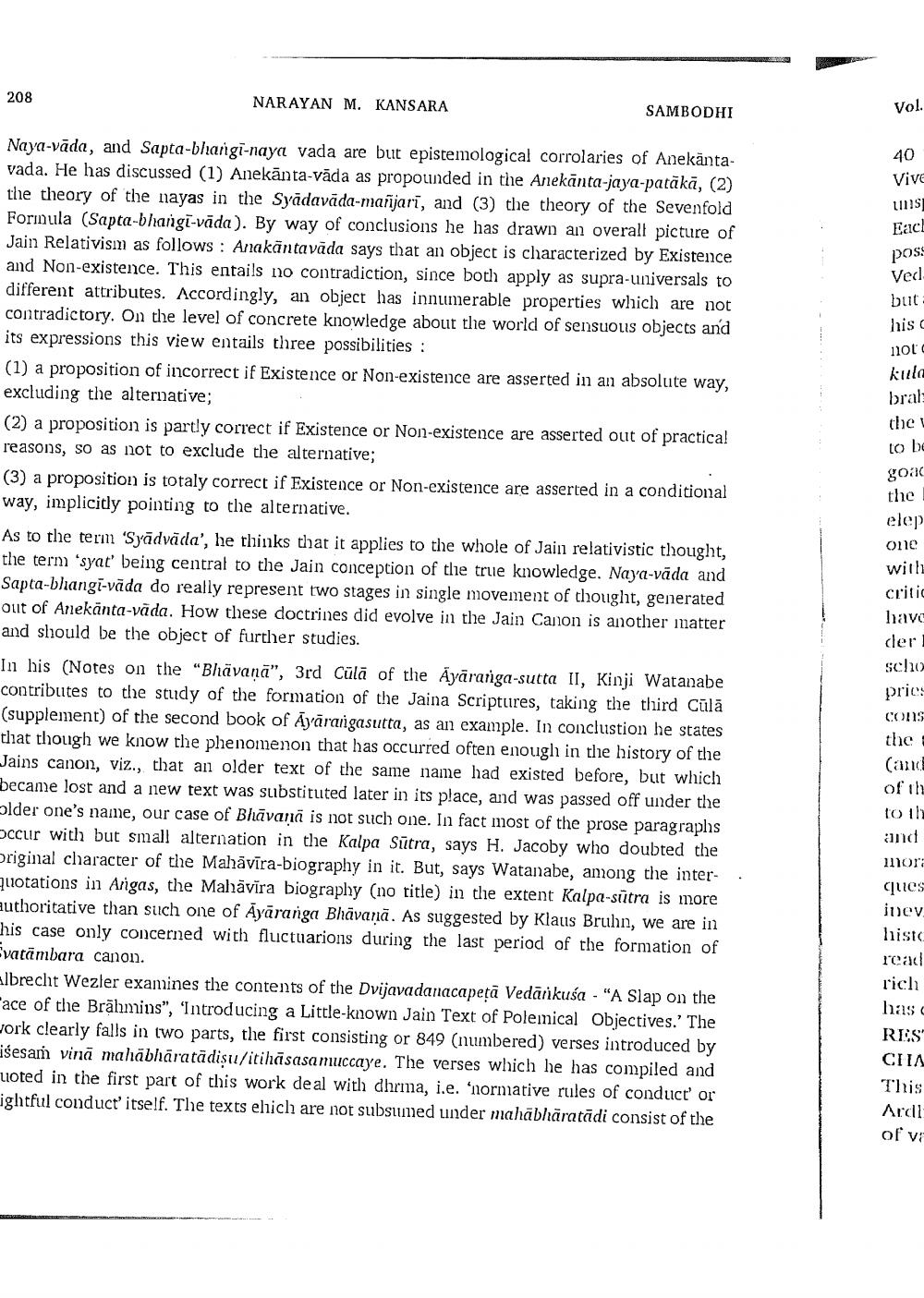________________
Vol.
08
NARAYAN M. KANSARA
SAMBODHI
40
Vive
LIISI
Eac! pos:
Ved but his 11011 kulla brah ther to bi
goac the
Vaya-vāda, and Sapta-bhangi-naya vada are but epistemological corrolaries of Anekanta
ada. He has discussed (1) Anekānta-vāda as propounded in the Anekānta-jaya-patākā, (2) the theory of the nayas in the Syādavāda-mañjarī, and (3) the theory of the Sevenfold Formula (Sapta-bhangi-vāda). By way of conclusions he has drawn an overalt picture of Jain Relativism as follows: Anakantavāda says that an object is characterized by Existence and Non-existence. This entails no contradiction, since both apply as supra-universals to different attributes. Accordingly, an object has innumerable properties which are not contradictory. On the level of concrete knowledge about the world of sensuous objects and Ets expressions this view entails three possibilities: (1) a proposition of incorrect if Existence or Non-existence are asserted in an absolute way, excluding the alternative; (2) a proposition is partly correct if Existence or Non-existence are asserted out of practical reasons, so as not to exclude the alternative; (3) a proposition is totaly correct if Existence or Non-existence are asserted in a conditional way, implicitly pointing to the alternative. As to the term 'Syādväda', he thinks that it applies to the whole of Jain relativistic thought, the term 'syat' being central to the Jain conception of tlie true knowledge. Naya-vāda and Sapta-bhangi-vāda do really represent two stages in single movement of thought, generated out of Anekānta-vāda. How these doctrines did evolve in the Jain Canon is another matter and should be the object of further studies. In his (Notes on the “Bhāvanā”, 3rd Cūlā of the Ayararga-sutta II, Kinji Watanabe contributes to the study of the formation of the Jaina Scriptures, taking the third Cūlā (supplement) of the second book of Āyāraiigasutta, as an example. In conclusion he states tliat though we know the phenomenon that has occurred often enough in the history of the Jains canon, viz., that an older text of the same name had existed before, but which became lost and a new text was substituted later in its place, and was passed off under the older one's name, our case of Bhāvanā is not such one. In fact most of the prose paragraphs occur with but small alternation in the Kalpa Sūtra, says H. Jacoby who doubted the original character of the Mahāvīra-biography in it. But, says Watanabe, among the inter-. quotations in Argas, the Mahāvīra biography (no title) in the extent Kalpa-sūtra is more iuthoritative than such one of Āyāranga Bhāvanā. As suggested by Klaus Bruhn, we are in his case only concerned with fluctuarions during the last period of the formation of vatambara canon. Albrecht Wezler examines the contents of the Dvijavadanacapeță Vedātikuša - "A Slap on the face of the Brāhmins”, 'Introducing a Little-known Jain Text of Polemical Objectives.' The york clearly falls in two parts, the first consisting or 849 (numbered) verses introduced by isesam vină mahābhāratādişu/itihāsasa muccaye. The verses which he has compiled and Lioted in the first part of this work deal with dhrma, i.e. 'normative rules of conductor ightful conduct' itself. The texts ehich are not subsumed under mahābhāratādi consist of the
elep one with criti have der! scho price cons the (and of th to 11 and MNO que ives liist
read
ricl has RES CH Thi
Λ of




